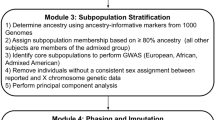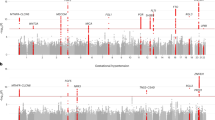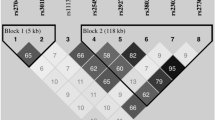Abstract
Genome-wide scans in Icelandic, Australian/New Zealand and Finnish pedigrees have provided evidence for maternal susceptibility loci for pre-eclampsia on chromosome 2, although at different positions (Iceland: 2p13 and 2q23, Australia/New Zealand: 2p11–12 and 2q22, Finland: 2p25). In this project, a large population-based (n=65 000) nested case–control study was performed in Norway to further explore the association between positional candidate genes on chromosome 2q and pre-eclampsia, using single-nucleotide polymorphisms (SNPs). DNA samples from 1139 cases (women with one or more pre-eclamptic pregnancies) and 2269 controls (women with normal pregnancies) were genotyped using the Applied Biosystems SNPlex high-throughput genotyping assay. In total, 71 SNPs within positional candidate genes at 2q22–23 locus on chromosome 2 were genotyped in each individual. Genotype data were statistically analysed with the sequential oligogenic linkage analysis routines (SOLAR) computer package. Nominal evidence of association was found for six SNPs (rs1014064, rs17742134, rs1424941, rs2161983, rs3768687 and rs3764955) within the activin receptor type 2 gene (ACVR2A) (all P-values <0.05). The non-independence of statistical tests due to linkage disequilibrium between SNPs at a false discovery rate of 5% identifies our four best SNPs (rs1424941, rs1014064, rs2161983 and rs3768687) to remain statistically significant. The fact that populations with different ancestors (Iceland/Norway–Australia/New Zealand) demonstrate a common maternal pre-eclampsia susceptibility locus on chromosome 2q22–23, may suggest a general role of this locus, and possibly the ACVR2A gene, in pre-eclampsia pathogenesis.
Similar content being viewed by others
Log in or create a free account to read this content
Gain free access to this article, as well as selected content from this journal and more on nature.com
or
References
Saftlas AF, Olson DR, Franks AL, Atrash HK, Pokras R : Epidemiology of preeclampsia and eclampsia in the United States, 1979–1986. Am J Obstet Gynecol 1990; 163: 460–465.
Taylor D : The epidemiology of hypertension during pregnancy. Amsterdam: Elsevier, 1988.
Arngrimsson R, Bjornsson S, Geirsson RT, Bjornsson H, Walker JJ, Snaedal G : Genetic and familial predisposition to eclampsia and pre-eclampsia in a defined population. Br J Obstet Gynaecol 1990; 97: 762–769.
Moses EK, Fitzpatrick E, Freed KA et al: Objective prioritization of positional candidate genes at a quantitative trait locus for pre-eclampsia on 2q22. Mol Hum Reprod 2006; 12: 505–512.
Salonen Ros H, Lichtenstein P, Lipworth L, Cnattingius S : Genetic effects on the liability of developing pre-eclampsia and gestational hypertension. Am J Med Genet 2000; 91: 256–260.
Chesley LC, Cooper DW : Genetics of hypertension in pregnancy: possible single gene control of pre-eclampsia and eclampsia in the descendants of eclamptic women. Br J Obstet Gynaecol 1986; 93: 898–908.
Cooper DW, Hill JA, Chesley LC, Bryans CI : Genetic control of susceptibility to eclampsia and miscarriage. Br J Obstet Gynaecol 1988; 95: 644–653.
Esplin MS, Fausett MB, Fraser A et al: Paternal and maternal components of the predisposition to preeclampsia. N Engl J Med 2001; 344: 867–872.
Lie RT, Rasmussen S, Brunborg H, Gjessing HK, Lie-Nielsen E, Irgens LM : Fetal and maternal contributions to risk of pre-eclampsia: population based study. BMJ 1998; 316: 1343–1347.
Arngrimsson R, Sigurard ttir S, Frigge ML et al: A genome-wide scan reveals a maternal susceptibility locus for pre-eclampsia on chromosome 2p13. Hum Mol Genet 1999; 8: 1799–1805.
Harrison GA, Humphrey KE, Jones N et al: A genomewide linkage study of preeclampsia/eclampsia reveals evidence for a candidate region on 4q. Am J Hum Genet 1997; 60: 1158–1167.
Lachmeijer AM, Arngrimsson R, Bastiaans EJ et al: A genome-wide scan for preeclampsia in the Netherlands. Eur J Hum Genet 2001; 9: 758–764.
Moses EK, Lade JA, Guo G et al: A genome scan in families from Australia and New Zealand confirms the presence of a maternal susceptibility locus for pre-eclampsia, on chromosome 2. Am J Hum Genet 2000; 67: 1581–1585.
Laivuori H, Lahermo P, Ollikainen V et al: Susceptibility loci for preeclampsia on chromosomes 2p25 and 9p13 in Finnish families. Am J Hum Genet 2003; 72: 168–177.
Caniggia I, Lye SJ, Cross JC : Activin is a local regulator of human cytotrophoblast cell differentiation. Endocrinology 1997; 138: 3976–3986.
Jones RL, Salamonsen LA, Findlay JK : Activin A promotes human endometrial stromal cell decidualization in vitro. J Clin Endocrinol Metab 2002; 87: 4001–4004.
Gribi R, Tanaka T, Harper-Summers R, Yu J : Expression of activin A in inflammatory arthropathies. Mol Cell Endocrinol 2001; 180: 163–167.
Hubner G, Brauchle M, Gregor M, Werner S : Activin A: a novel player and inflammatory marker in inflammatory bowel disease? Lab Invest 1997; 77: 311–318.
Phillips DJ, Jones KL, Scheerlinck JY, Hedger MP, de Kretser DM : Evidence for activin A and follistatin involvement in the systemic inflammatory response. Mol Cell Endocrinol 2001; 180: 155–162.
Engelse MA, Neele JM, van Achterberg TA et al: Human activin-A is expressed in the atherosclerotic lesion and promotes the contractile phenotype of smooth muscle cells. Circ Res 1999; 85: 931–939.
Kozaki K, Akishita M, Eto M et al: Role of activin-A and follistatin in foam cell formation of THP-1 macrophages. Arterioscler Thromb Vasc Biol 1997; 17: 2389–2394.
Holmen J, Kjelsaas M, Krüger Ø et al: Attitudes to genetic epidemiology–illustrated by questions for re-consent to 61 426 participants at HUNT. Norsk Epidemiologi (Nor J Epidemiol) 2004; 14: 27–31.
Holmen J, Midthjell K, Krüger Ø et al: The Nord-Trøndelag Health Study 1995–97 (HUNT 2): Objectives, contents, methods and participation. Norsk Epidemiologi 2003; 13: 19–32.
Moses EK, Johnson MP, Tommerdal L et al: Genetic association of preeclampsia to the inflammatory response gene SEPS1. Am J Obstet Gynecol 2008; 198: 336.e1–336.e5.
Masuda J, Takayama E, Satoh A et al: Levels of annexin IV and V in the plasma of pregnant and postpartum women. Thromb Haemost 2004; 91: 1129–1136.
Jaleel MA, Tsai AC, Sarkar S, Freedman PV, Rubin LP : Stromal cell-derived factor-1 (SDF-1) signalling regulates human placental trophoblast cell survival. Mol Hum Reprod 2004; 10: 901–909.
Manuelpillai U, Ligam P, Smythe G, Wallace EM, Hirst J, Walker DW : Identification of kynurenine pathway enzyme mRNAs and metabolites in human placenta: up-regulation by inflammatory stimuli and with clinical infection. Am J Obstet Gynecol 2005; 192: 280–288.
Hernandez PA, Gorlin RJ, Lukens JN et al: Mutations in the chemokine receptor gene CXCR4 are associated with WHIM syndrome, a combined immunodeficiency disease. Nat Genet 2003; 34: 70–74.
Almasy L, Blangero J : Multipoint quantitative-trait linkage analysis in general pedigrees. Am J Hum Genet 1998; 62: 1198–1211.
Boerwinkle E, Chakraborty R, Sing CF : The use of measured genotype information in the analysis of quantitative phenotypes in man. I. Models and analytical methods. Ann Hum Genet 1986; 50: 181–194.
Li J, Ji L : Adjusting multiple testing in multilocus analyses using the eigenvalues of a correlation matrix. Heredity 2005; 95: 221–227.
Benjamini Y, Drai D, Elmer G, Kafkafi N, Golani I : Controlling the false discovery rate in behavior genetics research. Behav Brain Res 2001; 125: 279–284.
Blangero J, Goring HH, Kent Jr JW et al: Quantitative trait nucleotide analysis using Bayesian model selection. Hum Biol 2005; 77: 541–559.
Cocolakis E, Lemay S, Ali S, Lebrun JJ : The p38 MAPK pathway is required for cell growth inhibition of human breast cancer cells in response to activin. J Biol Chem 2001; 276: 18430–18436.
Zhang Z, Zhao Y, Batres Y, Lin MF, Ying SY : Regulation of growth and prostatic marker expression by activin A in an androgen-sensitive prostate cancer cell line LNCAP. Biochem Biophys Res Commun 1997; 234: 362–365.
Donaldson CJ, Mathews LS, Vale WW : Molecular cloning and binding properties of the human type II activin receptor. Biochem Biophys Res Commun 1992; 184: 310–316.
Mathews LS, Vale WW : Expression cloning of an activin receptor, a predicted transmembrane serine kinase. Cell 1991; 65: 973–982.
Hilden K, Tuuri T, Eramaa M, Ritvos O : Expression of type II activin receptor genes during differentiation of human K562 cells and cDNA cloning of the human type IIB activin receptor. Blood 1994; 83: 2163–2170.
Schneider-Kolsky ME, Manuelpillai U, Waldron K, Dole A, Wallace EM : The distribution of activin and activin receptors in gestational tissues across human pregnancy and during labour. Placenta 2002; 23: 294–302.
Jones RL, Findlay JK, Salamonsen LA : The role of activins during decidualisation of human endometrium. Aust N Z J Obstet Gynaecol 2006; 46: 245–249.
Petraglia F, Vaughan J, Vale W : Inhibin and activin modulate the release of gonadotropin-releasing hormone, human chorionic gonadotropin, and progesterone from cultured human placental cells. Proc Natl Acad Sci USA 1989; 86: 5114–5117.
Petraglia F, Anceschi MM, Calza L et al: Inhibin and activin in human fetal membranes: evidence for a local effect on prostaglandin release. J Clin Endocrinol Metab 1993; 77: 542–548.
Bersinger NA, Smarason AK, Muttukrishna S, Groome NP, Redman CW : Women with preeclampsia have increased serum levels of pregnancy-associated plasma protein A (PAPP-A), inhibin A, activin A and soluble E-selectin. Hypertens Pregnancy 2003; 22: 45–55.
D′Antona D, Reis FM, Benedetto C et al: Increased maternal serum activin A but not follistatin levels in pregnant women with hypertensive disorders. J Endocrinol 2000; 165: 157–162.
Laivuori H, Kaaja R, Turpeinen U, Stenman UH, Ylikorkala O : Serum activin A and inhibin A elevated in pre-eclampsia: no relation to insulin sensitivity. Br J Obstet Gynaecol 1999; 106: 1298–1303.
Muttukrishna S, Knight PG, Groome NP, Redman CW, Ledger WL : Activin A and inhibin A as possible endocrine markers for pre-eclampsia. Lancet 1997; 349: 1285–1288.
Petraglia F, Aguzzoli L, Gallinelli A et al: Hypertension in pregnancy: changes in activin A maternal serum concentration. Placenta 1995; 16: 447–454.
Silver HM, Lambert-Messerlian GM, Star JA, Hogan J, Canick JA : Comparison of maternal serum total activin A and inhibin A in normal, preeclamptic, and nonproteinuric gestationally hypertensive pregnancies. Am J Obstet Gynecol 1999; 180: 1131–1137.
Petraglia F, Sawchenko P, Lim AT, Rivier J, Vale W : Localization, secretion, and action of inhibin in human placenta. Science 1987; 237: 187–189.
Smith C, Yndestad A, Halvorsen B et al: Potential anti-inflammatory role of activin A in acute coronary syndromes. J Am Coll Cardiol 2004; 44: 369–375.
Bellamy L, Casas JP, Hingorani AD, Williams DJ : Pre-eclampsia and risk of cardiovascular disease and cancer in later life: systematic review and meta-analysis. Bmj 2007; 335: 974.
Dhar SK, Delmolino L, Dutta A : Architecture of the human origin recognition complex. J Biol Chem 2001; 276: 29067–29071.
Acknowledgements
The Nord-Trøndelag Health Study (the HUNT study) is a collaboration between the HUNT Research Centre, Faculty of Medicine, NTNU, the Norwegian Institute of Public Health and the Nord-Trøndelag County Council. We thank Drs Harald HH Göring and Åsa Johansson for their constructive review of the manuscript. This study was supported by grants from the Central Norway Regional Health Authority and the Medical Faculty and Office of International Relations at NTNU (Linda T Roten), the Cowles Post-Doctoral Fellowship (Matthew P Johnson), the Elizabeth Huth Coates Charitable Foundation and grants from the National Institutes of Health. (Eric K Moses, R01HD049847; John Blangero, MH59490). Genotyping and statistical analysis were conducted in facilities constructed with support for the Research Facilities Improvement Program Grant Numbers C06 RR013556 and C06 RR017515 from the National Center for Research Resources, NIH.
Author information
Authors and Affiliations
Corresponding author
Rights and permissions
About this article
Cite this article
Roten, L., Johnson, M., Forsmo, S. et al. Association between the candidate susceptibility gene ACVR2A on chromosome 2q22 and pre-eclampsia in a large Norwegian population-based study (the HUNT study). Eur J Hum Genet 17, 250–257 (2009). https://doi.org/10.1038/ejhg.2008.158
Received:
Revised:
Accepted:
Published:
Issue date:
DOI: https://doi.org/10.1038/ejhg.2008.158
Keywords
This article is cited by
-
Genetic variants in myostatin and its receptors promote elite athlete status
BMC Genomics (2023)
-
Machine-learning predictive model of pregnancy-induced hypertension in the first trimester
Hypertension Research (2023)
-
Genetic variants in anti-Müllerian hormone-related genes and breast cancer risk: results from the AMBER consortium
Breast Cancer Research and Treatment (2021)
-
Non-additive effects of ACVR2A in preeclampsia in a Philippine population
BMC Pregnancy and Childbirth (2019)
-
ADIPOQ +45T>G, +712A>G and +4545C>G variants are associated with dyslipidemia in Chinese pre-eclampsia women
International Journal of Diabetes in Developing Countries (2015)



